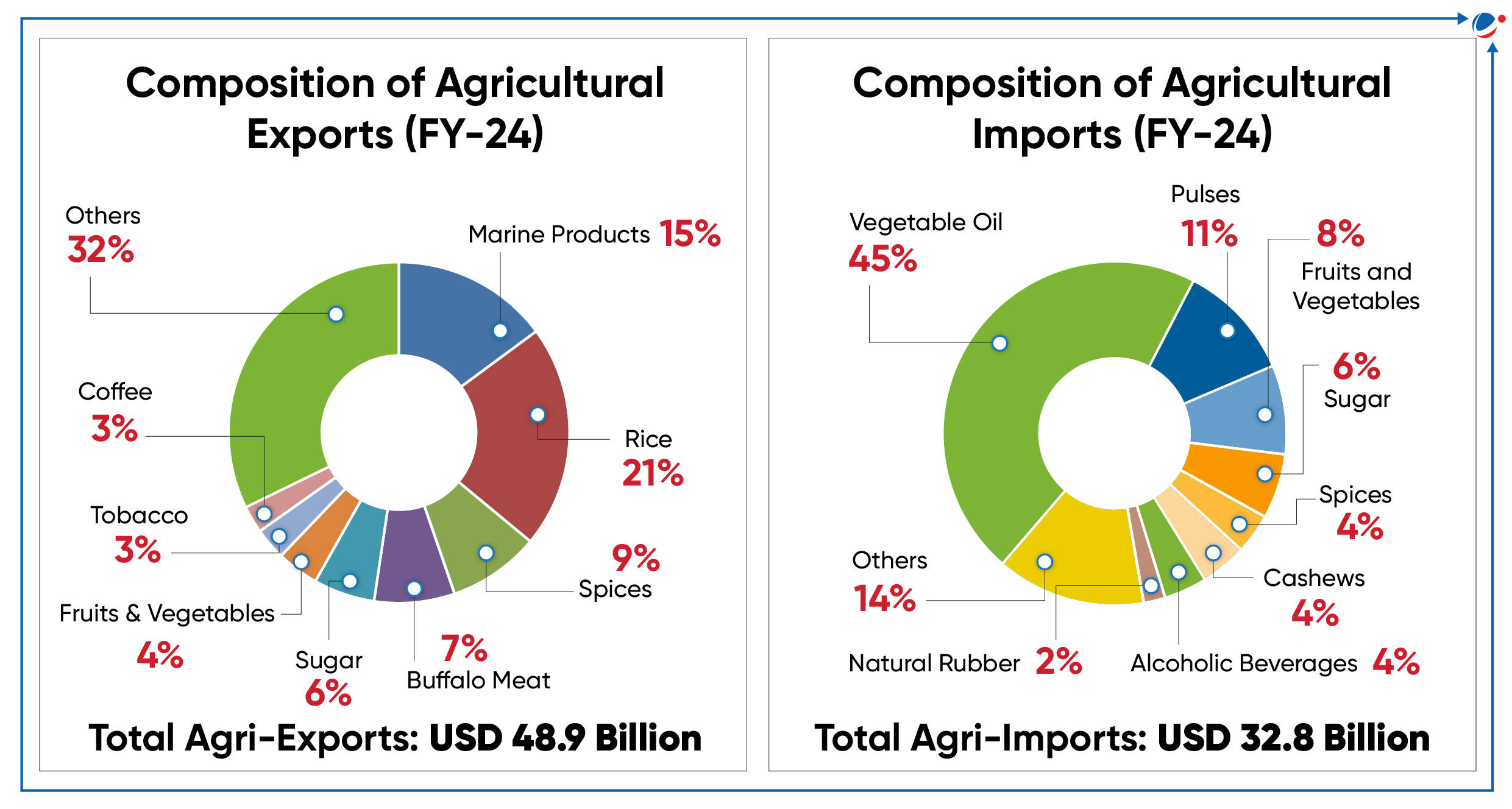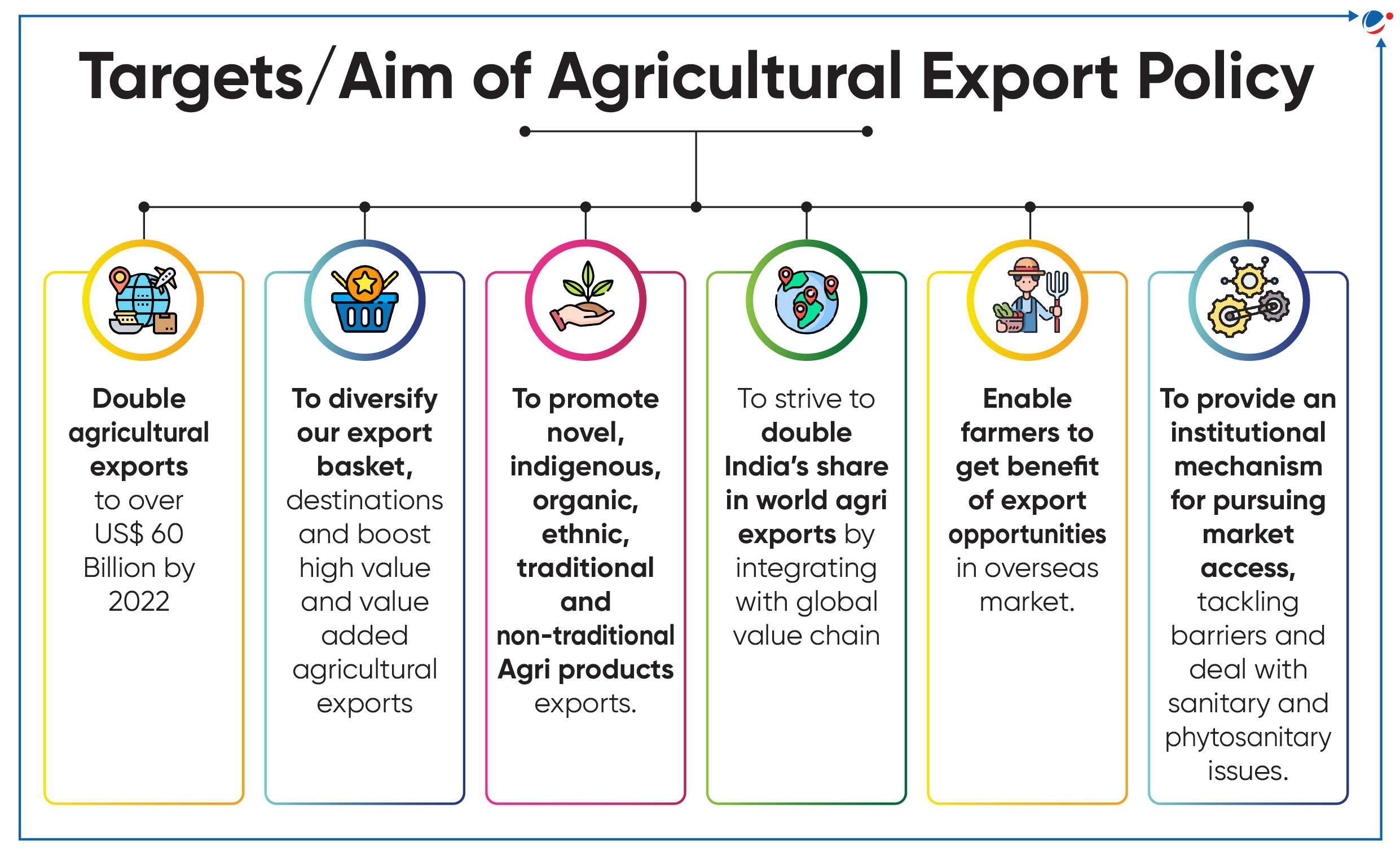Why in the News?
Agricultural exports in India registered 8% decline this year (2023 – 24) and fell short of the ambitious target of $60 billion by 2022 (set by India's Agricultural Export Policy, 2018).
More on news
- Agricultural Exports touched $48.9 billion in 2023-24, registering a decline from $53.2 billion in 2022-23.
- India's agricultural imports in Year 2023-24 also registered a notable decline of 8%, dropping from $35.7 billion in 2022-23 to $32.8 billion in 2023-24.
- As per available WTO's Trade Statistical Review (2023), the share of India's agricultural exports and imports in world agriculture trade in 2022 were 2.4% and 1.9%, respectively.
- India was ranked 9th in ranking of the global Agri exporters.


Agriculture Export Policy (AEP) 2018

- About: It is framed with a focus on agriculture export oriented production, export promotion, better farmer realization and synchronization within policies and programs of Government of India.
- Objective: To Increase Farmer income through value addition and minimize losses across value chain.
- Elements of Agriculture Export Policy Framework:
- Strategic Recommendations: Consist of Stable trade Policy Measures, Infrastructure and Logistics Support, Holistic Approach to boost exports & Greater involvement of State Governments in Agriculture Exports.
- Operational Recommendations: It provides focus on building Clusters, Promoting Value added exports, Marketing and promotion of "Brand India", Attract private investments into production and processing, Establishment of Strong Quality Regimen, & Increased Research & Development.
Need for New Export Policy
- Prevalence of Export Restrictions: E.g. Export prohibition, export duties, minimum export price etc.
- It can create uncertainty and unpredictability for India's agricultural producers and exporters. Proliferated use of trade policy instruments makes AEP dichotomous, ambiguous, and paradoxical.
- It may also lead to ambiguity on India emerging as a reliable supplier of agricultural products to world markets.
- Global Price Sensitivity: India's export competitiveness is heavily influenced by dynamics between domestic and global commodity price.
- When global prices are on upswing, India's agri-exports also surge. But when global prices fall, our price-competitiveness also gets blunted, and agri-exports suffer.
- WTO issue: Use of export restrictions on sensitive agriculture products has been a contentious issue in World Trade Organization (WTO) as they are seen as a violation of WTO rules.
- As India announced its rice export restrictions, the international price of rice surged by approximately 25%.v
- Limited Basket of Export: Rice and sugar account for 37.4% of India's exports. They face frequent export bans in India, for example export of non-basmati rice is currently banned from India.
- Virtual water export: Producing rice uses a lot of water (3,000-5,000 liters per kg) and exporting 16.3 million tons of rice equals exporting 32.6 billion cubic meters of water. Subsidies on power and fertilizers make rice artificially cheap, hiding the real environmental cost.
Way-forward
- True export competitiveness: Focusing on improving domestic production through productivity growth, product differentiation, value addition, market access, and branding to promote sustainable growth in agricultural exports.
- Bringing more technology: Promote advanced agricultural technologies, precision farming, and efficient irrigation, while supporting agri-startups and innovative solutions to boost productivity and export efficiency.
- Netherlands has used advances in vertical farming, seed technology and robotics to become a global model. Despite being a small country, it is second largest exporter of agriculture.
- Focus on Organic & Processed food products: There is also a need to ensure the development of organic or pesticide-free clusters through farmer producer organizations to boost export of organic products to high-income countries.
- Centre's policy should be in direction of nurturing food processing companies, ensuring low cost of production and global food quality standards.
- Environmental sustainability: Emphasis on crops like pulses and oilseeds that require less water and fertilizers. Farmers' interests need to be balanced with environmental sustainability.
- Considering Climatic variations while determining Import Policies: To ensure food security and stabilize market prices.
Steps taken for promoting Agricultural - export:
|



